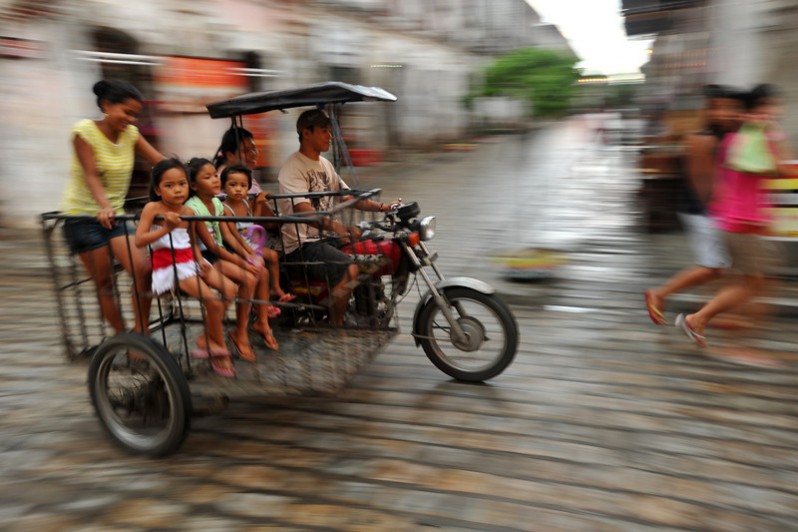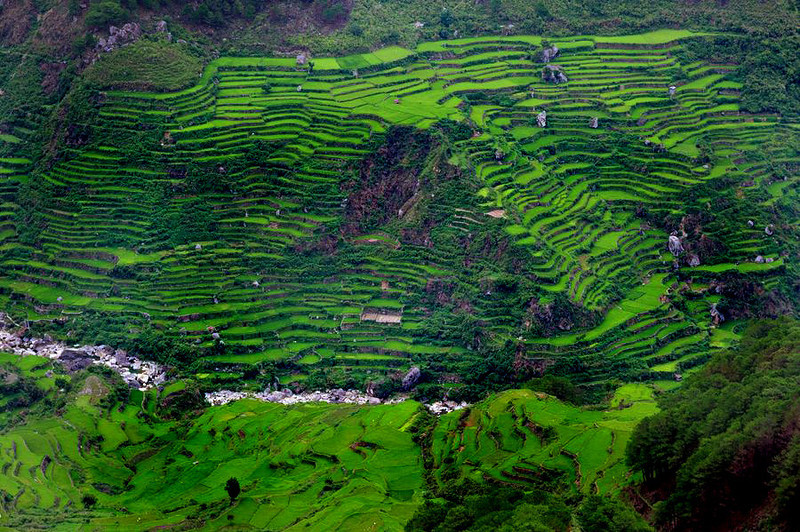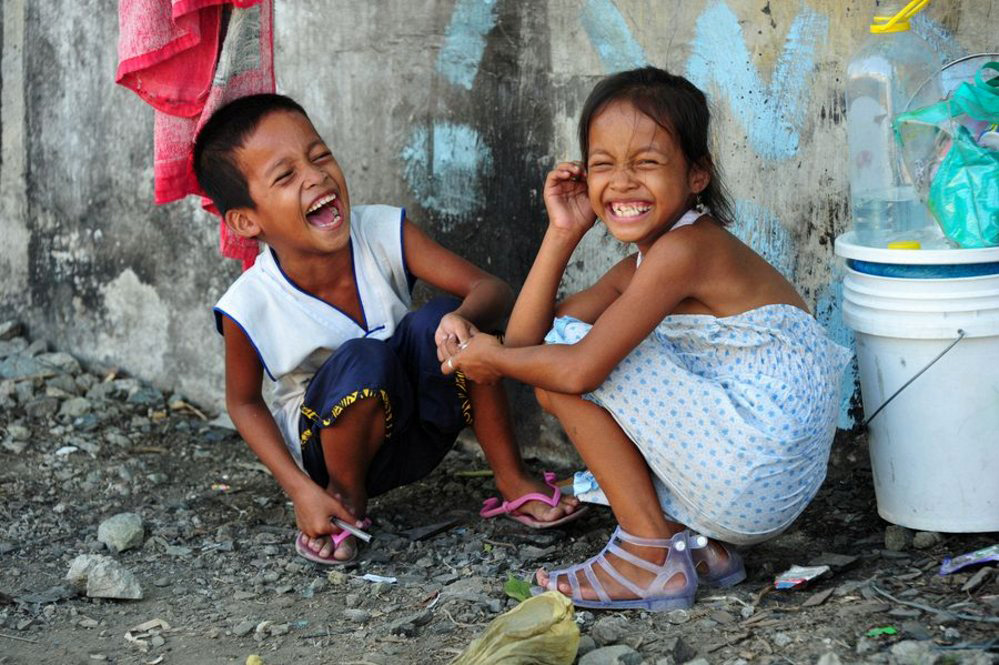“I flew to the Philippines, but I had no idea what to expect . . . I was assuming it would be another opportunity to improve my photography skills. Little did I know . . . the countryside with the endless green rice terraces, the magnificent mountains, the islands with their amazing white sandy beaches – all so heartbreaking beautiful. The Filipinos are the warmest, nicest people one can imagine, whether living in the big city of Manila, old Vigan or the Island of Bohol. What a great and wonderful surprise” —- Ruti Alon, Israel
The Philippines, known as Pearl of the Orient is one of the great treasures of Southeast Asia. Often overlooked by travellers, the Philippines rewards those who go the extra distance to reach and explore it. Because it’s off the beaten path, the Philippines is a great place to escape the multitudes who descend upon other parts of Southeast Asia. The country is the second-largest archipelago in the world, being composed of more than 7,000 islands. The Philippines offers up fantastic landscapes and natural wonders to stagger even the most jaded traveler: Boasting several UNESCO World Heritage sites, including Banaue, with its stunning rice terraces and Vigan, with its fascinating reminders of the islands’ rich Spanish colonial history, the Philippines has so much to offer. And, if you enjoy palm-fringed, white-sand beaches, the Philippines offers that too, on a scale and beauty that one might have expected to find in Hawaii decades ago. Oh, just so you know, we’ll be ending our Philippines tour on just such a beach; with a few nights at my secret hide-away, the Amarela Beach Resort, on the island of Panglao.

This trip is limited to just 10 participants and as I write this, there are still a few spots left to sign up! The 14 night trip includes luxurious accommodation for 14 hotel nights, all airport transfers, ground transportation, in-country flights, all breakfasts, all dinners, entrances to tourist sites, boat rides, English-speaking guides, and drinking water. This is the second year I’m running this trip and in this blog post, I would like to share with you some images of last year’s tour.

The Philippine culture, has affinities with the Spain due to three centuries of colonial rule, and has an American influence, largely the result of a major military presence during World War II, but which actually started as early as 1898. The Philippines rich culture and tradition reflects the diverse indigenous groups from its many islands. Roman Catholicism is the predominant religion, being the only Catholic country in Southeast Asia. Tagalog is the official language while English is widely spoken.

Travelers who have been to the Philippines will universally comment that it’s the Filipinos themselves who make the country such a joy to visit. Photo friendly and full of smiles, the people open themselves and their lives to visitors on a scale only matched by places like India and Myanmar. The Philippines truly qualifies as one of the last great frontiers in Southeast Asia. This is your chance to be among the few to explore and photograph this amazing destination.
The favorite part for me was discovering the beauty of a country that I knew very little about. I was also very taken by the friendliness and openness of almost all of the Filippinos we met and we photographed. Not only were they very friendly and polite (even in the poorest areas-e.g railroad bridge in Manila) but there seemed to be a real sense of community – i.e. of caring for their neighbors and family — Herb Horowitz–


The Ubiquitous “sari-sari stores”, like the one pictured above, are the “convenience stores” of the Philippines. The word sari-sari is Tagalog meaning “variety”. Such stores form an important economic and social location in a Filipino community. Most sari-sari stores are privately owned shops and are operated inside the shopkeeper’s house. Sari-sari stores are a place were Filipino’s meet and hang out, and the small shops are always a great backdrop for our photography.

Throughout the Philippines, Jeepneys are the most popular means of public transportation. They were originally made from US military jeeps left over from World War II and are known for their flamboyant decoration and crowded seating. They have become a ubiquitous symbol of Philippine culture. The word jeepney is a combination of “jeep” and “Jitney”. To make our Manila city tour completely “authentic”, my friend, photojournalist, Red Santos, makes arrangements for us to rent his uncle’s Jeepney. The locals always get a kick out of seeing a group of foreigners using the traditional means of transport. Our day in the Jeepney is an experience that you won’t soon forget!

On the island of Bohol we visit the Tarsier Research and Development Center to photograph the Tarsier, a strange, tiny monkey with large eyes which is only about 3 to 6 inches in height, making it one of the smallest primates. The Tarsier’s eyes are fixed in its skull; they cannot turn in their sockets. Instead, a special adaptation in the neck allows its round head to be rotated 180 degrees. As you can see, the eyes are disproportionately large, having the largest eye-to-body size ratio of all mammals. These huge eyes provide this nocturnal animal with excellent night vision. The tarsier is said to be the inspiration for Steven Speilberg’s famous E.T. creature. You’ll realize that when you see the tarsier’s fingers!

After photographing Tarsiers, we take a boat ride through the local jungle, and on the way back to the hotel make a short stop to photograph the Chocolate Hills. The Chocolate Hills is a rolling terrain of haycock hills – mounds of general shape which are conical and almost symmetrical. The mounds are made of grass-covered limestone. The domes vary in sizes from 98 to 160 ft high with the largest being 390 ft in height. During the dry season, the grass-covered hills dry up and turn chocolate brown. This transforms the area into seemingly endless rows of “chocolate kisses”.

We visit northern Luzon, the Philippine’s Cordillera region, where the weather is downright cold in the morning. From our comfortable lodge accommodations, located at almost 5,000 ft of elevation, we rise early to take sunrise photos of some of the most amazing rice terraces you’ll ever see. Later we make a short hike through a pine forest to visit Sagada’s famous “hanging coffins”.

Hanging coffins are an ancient funeral custom in northern Luzon. In several areas, coffins of various shapes can be seen hanging either on beams projecting outward from vertical faces of the mountain, in caves in the face of cliffs, or on natural rock projections. The coffins are quite small due to the fact that the deceased are placed in the fetal position, believing that people should leave the world in the same position as they entered it.

In the UNESCO World Heritage city of Vigan, the use of the handlooms and other weaving accessories can be traced from early Spanish occupation. This equipment was used in homes to weave cloth for blankets, pillow cases and clothes. These crafts were said to be a major export during the period of the Spanish galleon trade. Today weavers are still active using age-old methods of creating this traditional craft.

Pottery making in Vigan was introduced by early Chinese immigrants. The west side of Vigan is abundant in grade A clay used in jar and pottery- making in nearby barangays/villages. The jar-making trade was passed on from generation to generation and is still very active in Vigan.

In pre-colonial times, Vigan was an important trading post for Chinese junks, trading gold beeswax and other products from the central Cordilleras for exotic Asian goods. Many Chinese traders settled in the mestizo district, marrying locals and starting new bloodlines. Vigan was captured and settled by the Spanish in 1572, and grew to become a center of Spanish political and religious power in the north of Luzon.

The cobblestone streets of Vigan’s historic district, where horse-drawn carriages are still a popular form of transportation, provide a wonderful setting for our photographs. The horse drawn carriage or “calesa” was one of the modes of transportation introduced in the Philippines in the 18th century by the Spaniards that only nobles and high ranked officials could afford. Although the calesa has become a rarity, some century-old examples are still preserved in areas of the Philippines, such as the city of Vigan and Laoag. We will not only photograph these wonderful carriages, but we’ll also use them for a city tour of this fascinating and photogenic UNESCO World Heritage city.

The Philippines truly is an off-the-beaten-path destination, it’s an undiscovered gem with so much to explore, photograph and enjoy. This is your chance to be a pioneer, to visit a place that others overlook; to be among the first to discover this wonderful country.
To register for the Philippines Photo Tour, which runs from June 16-30, sign up by clicking here , then navigate to the “registration tab”.
If you’ve read this far, then your probably interested in finding out more about the Philippines Photo tour, why not have a look at what last year’s participants posted. To visit Anietra Hampers blog posts, click on the following links: There is such a thing as the Philippines Happiness Index (PHI). , The Road to Sagada: ,Preparation for the Philippines trip and “Do I want what in my coffee?”
And, don’t miss paging through an on-line Blurb photo book entitled, “Wonderful Philippines”, made up of a gallery of each participant’s images from last year’s inaugural tour.
I hope to see you in Manila on June 16th!
Mabuhay,
Karl










would love to join and hang out with you guys when you arrive in manila